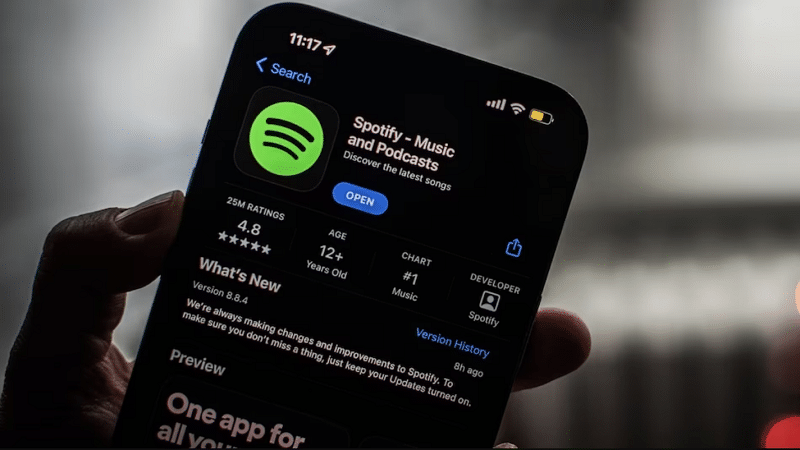Spotify’s Strategic Shift: Dodging Apple’s App Store Fees in the EU
In the evolving landscape of digital markets and antitrust laws, Spotify’s latest maneuver in Europe marks a significant shift. The Swedish audio streaming giant is set to bypass Apple’s notorious 30 percent fee on App Store purchases, a move facilitated by the European Union’s groundbreaking Digital Markets Act (DMA). This article delves deep into the implications of this strategic shift, not just for Spotify and Apple, but for the entire tech industry and app developers globally.
The Catalyst: Europe’s Digital Markets Act and Its Ripple Effect
The EU’s DMA, a robust framework aimed at leveling the playing field in the digital sector, has been a game changer. It compels Big Tech firms to alter their longstanding practices, focusing on fairness and transparency. Spotify’s ability to sidestep Apple’s fees is a direct outcome of this act. We’ll explore how this law reshapes the tech landscape and what it means for consumer choices and developer opportunities.
Spotify vs. Apple: A Saga of Fees, Fairness, and Frustration
Spotify’s decision is the climax of a years-long dispute with Apple. The crux of this contention has been the hefty fees and stringent rules imposed by the App Store, which Spotify claims have unfairly impacted its pricing strategy and competitive position. This section will unravel the history of this clash, highlighting the challenges and frustrations faced by app developers under Apple’s regime.
Unpacking the Financial Impacts: Calculating the Cost of Compliance
The financial ramifications of Apple’s 30 percent fee are significant. Here, we’ll break down the numbers, showing how this fee structure has affected Spotify’s pricing and revenue models. This analysis will provide a clear picture of the financial burden that app developers bear under such policies.
Consumer Choices and Market Dynamics: A New Era in the App Economy
Spotify’s move under the DMA heralds a new era for consumer choices in the app economy. With more direct purchase options and potentially lower prices, users stand to benefit. This section will examine how these changes might alter consumer behavior and market dynamics, potentially leading to more competitive pricing and innovative service offerings.
Legal Battles and Corporate Pushbacks: The Broader Tech Industry Response
The broader tech industry’s response to such regulatory changes is complex and multifaceted. This part will delve into the legal battles, corporate strategies, and lobbying efforts by Big Tech, including Apple’s challenge against the DMA and the response from other industry giants like Meta.
The Developer’s Dilemma: Navigating the New Landscape
App developers are at the heart of this transformation. How they navigate these changes, leverage new opportunities, and adapt to the evolving rules will be crucial. This section will discuss the potential strategies and adaptations developers might consider in this new landscape.
Regulatory Repercussions: EU’s Influence on Global Tech Policies
The EU’s regulatory approach often sets precedents for other regions. We’ll explore how the DMA could influence global tech policies, potentially inspiring similar legislation in other parts of the world and changing the way tech companies operate globally.
In-App Purchases and Subscription Models: Analyzing the Alternatives
With the freedom to bypass Apple’s fees, Spotify and other apps might experiment with new in-app purchase and subscription models. This part will analyze the potential alternatives and innovations that could emerge, enhancing user experience and monetization strategies.
The User Experience: How Will It Change?
Changes in the backend often translate to a different user experience. Here, we’ll speculate on how Spotify’s strategic shift might affect its user interface, functionality, and overall user satisfaction.
Apple’s Counterstrategy: Adapting to the DMA Regulations
Apple’s response to the DMA regulations will be crucial. This section will predict Apple’s potential counterstrategies, examining how the tech giant might adapt its business model and App Store policies in response to these regulatory changes.
Spotify’s Position in the Streaming Market: A Competitive Analysis
Understanding Spotify’s position in the streaming market is key to assessing the impact of its decision. We’ll conduct a competitive analysis of Spotify in the context of its rivals, evaluating its strengths, weaknesses, opportunities, and threats in the new regulatory environment.
Data Privacy and Security Considerations
With new purchasing avenues, data privacy and security become more critical. This part will discuss the implications of these changes on user data protection and the measures Spotify and similar apps might need to implement.
Future of App Monetization: Trends and Predictions
The future of app monetization is poised for change. We’ll explore the emerging trends and make predictions about how app monetization strategies might evolve in the post-DMA era.
Impact on Small and Independent Developers
The impact of these changes isn’t limited to tech giants. This section will examine the implications for small and independent app developers, discussing how they can benefit from a more equitable market.
Regulatory Compliance: Challenges and Opportunities
Adhering to new regulations like the DMA presents both challenges and opportunities. We’ll explore these aspects, focusing on how companies can effectively comply while capitalizing on the opportunities presented by these laws.
Innovation in the App Industry: A New Wave of Creativity
Regulatory changes often spur innovation. This part will highlight how the new rules might inspire a wave of creativity in the app industry, leading to novel features, services, and business models.
Global Market Shifts: Analyzing the Worldwide Impact
The EU’s DMA might influence market dynamics globally. This section will analyze the potential worldwide impact of these regulatory changes, considering how different regions might react and adapt.
User Engagement and Retention Strategies
In light of these changes, app developers need to rethink their user engagement and retention strategies. This part will offer insights into effective strategies for maintaining and growing a user base in a changing market environment.
The Future of Apple’s App Store: Evolving Business Models
As the landscape shifts, so must Apple’s App Store. We’ll speculate on the future of the App Store, considering how Apple might alter its business model and policies to stay competitive and compliant.
Antitrust Laws and Tech Regulation: A Global Perspective
Finally, we’ll take a broader look at antitrust laws and tech regulation globally, discussing how different countries approach these issues and what it means for the future of the tech industry.
Spotify Avoids Apple’s App Store Fees
Under the new EU regulations, Spotify will now offer direct purchase options for audiobooks and subscriptions within its app, circumventing Apple’s 30% fee. This strategic shift not only impacts Spotify’s revenue model but also sets a precedent for other apps operating under similar constraints. It’s a bold move that underscores the growing tension between app developers and tech giants over market control and revenue sharing.
The Legal Tug-of-War: Ongoing Disputes and Future Implications
Spotify’s legal battles with Apple highlight a larger issue in the tech industry: the struggle for fair market practices. With the DMA now in effect, these disputes could see significant developments, potentially reshaping the legal landscape for tech companies and app developers alike. This section will explore the ongoing legal tug-of-war and its future implications.
User-Centric Strategies: Enhancing the Spotify Experience
In response to the new regulations, Spotify’s strategies will likely become more user-centric. This could lead to enhanced user experiences, from improved app functionalities to more attractive pricing models. We’ll delve into how Spotify might leverage this opportunity to strengthen its relationship with users.
Navigating New Market Realities: A Roadmap for App Developers
App developers, both large and small, must navigate these new market realities. This section will provide a roadmap for developers, offering strategies and insights on how to adapt and thrive in this evolving landscape.
Conclusion: A New Chapter in Digital Markets
In conclusion, Spotify’s move to avoid Apple’s App Store fees under the EU’s DMA is more than just a corporate strategy; it represents a new chapter in the digital market’s evolution. It’s a story of regulatory impact, market dynamics, and the ongoing quest for a fair and competitive digital ecosystem.

Big Sale Amazon”
Amazon Sale, Discounted Deals & Offers Alert
and Get Upto 90% Discount on All products
Join Us Today
FAQs
How will Spotify’s decision to bypass Apple’s fees affect its subscription prices? Spotify’s decision to bypass Apple’s fees could lead to more competitive subscription prices, as it eliminates the need to cover the additional costs imposed by the App Store.
What are the broader implications of the EU’s Digital Markets Act for the tech industry? The EU’s DMA is set to have significant implications for the tech industry, including promoting fair competition, changing revenue models, and potentially inspiring similar legislation in other regions.
How might Apple respond to these regulatory changes? Apple may adapt its App Store policies and business strategies to comply with the DMA, possibly by revising its fee structure or introducing new services and features.
What does this mean for app developers and the app economy? For app developers, the DMA opens up new opportunities for innovation and competition, potentially leading to a more vibrant and diverse app economy.
Can other apps follow Spotify’s lead in bypassing Apple’s fees? Yes, other apps operating in the EU may also leverage the DMA to offer alternative purchasing options and bypass Apple’s App Store fees.










